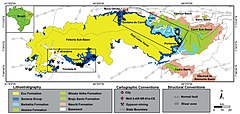| Santana Group | |
|---|---|
| Stratigraphic range: Aptian-Albian ~ | |
 Outcrop of the Santana Group; Ipubi & Romualdo Formations | |
| Type | Group |
| Sub-units | Romualdo, Ipubi & Crato Formations |
| Underlies | Araripina & Exu Formations |
| Overlies | Barbalha Formation |
| Lithology | |
| Primary | Mudstone, sandstone, shale, anhydrite |
| Other | Limestone, marl, siltstone |
| Location | |
| Coordinates | 5°36′S 64°18′W / 5.6°S 64.3°W |
| Approximate paleocoordinates | 9°12′S 34°00′W / 9.2°S 34.0°W |
| Region | |
| Country | |
| Extent | Araripe Basin |
| Type section | |
| Named for | Santana do Cariri |
 Extent of the Santana Group in blue | |
The Santana Group is a geologic group, formerly included as the middle part of the Araripe Group, in the Araripe Basin of northeastern Brazil. The group comprises the Crato, Ipubi and Romualdo Formations and is dated to the Aptian to Albian stages of the Early Cretaceous. The formations of the group were deposited in a lacustrine to subtidal shallow marine environment in the Araripe rift basin.[1]
The Santana Group has provided a rich assemblage of fossils; flora, fish, arthropods insects, turtles, snakes, dinosaurs including Irritator, and pterosaurs such as Thalassodromeus. The stratigraphic units of the group contained several feathers of birds, among those the first record of Mesozoic birds in Brazil. The Romualdo and Crato Formations are renowned for their excellent conservation and designated Lagerstätten. In 2006, the Araripe Basin was designated a UNESCO Global Geopark.
- ^ Santana Group at Fossilworks.org